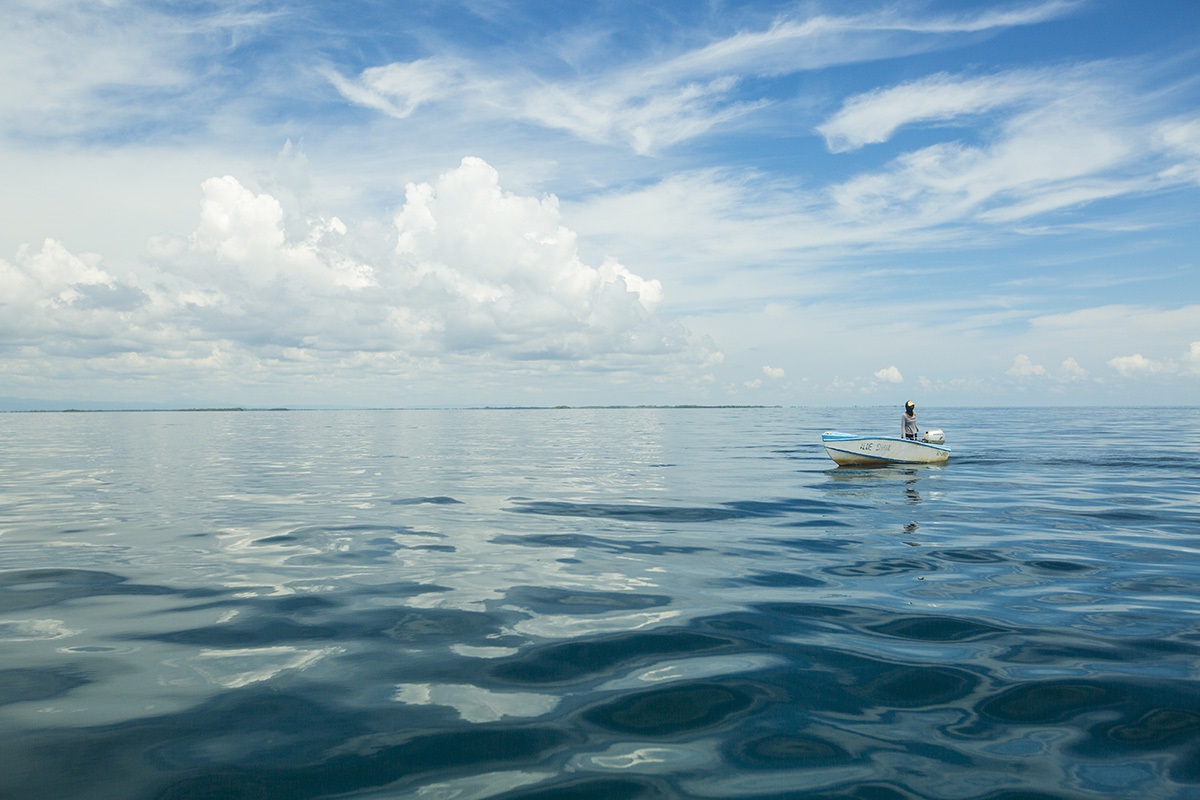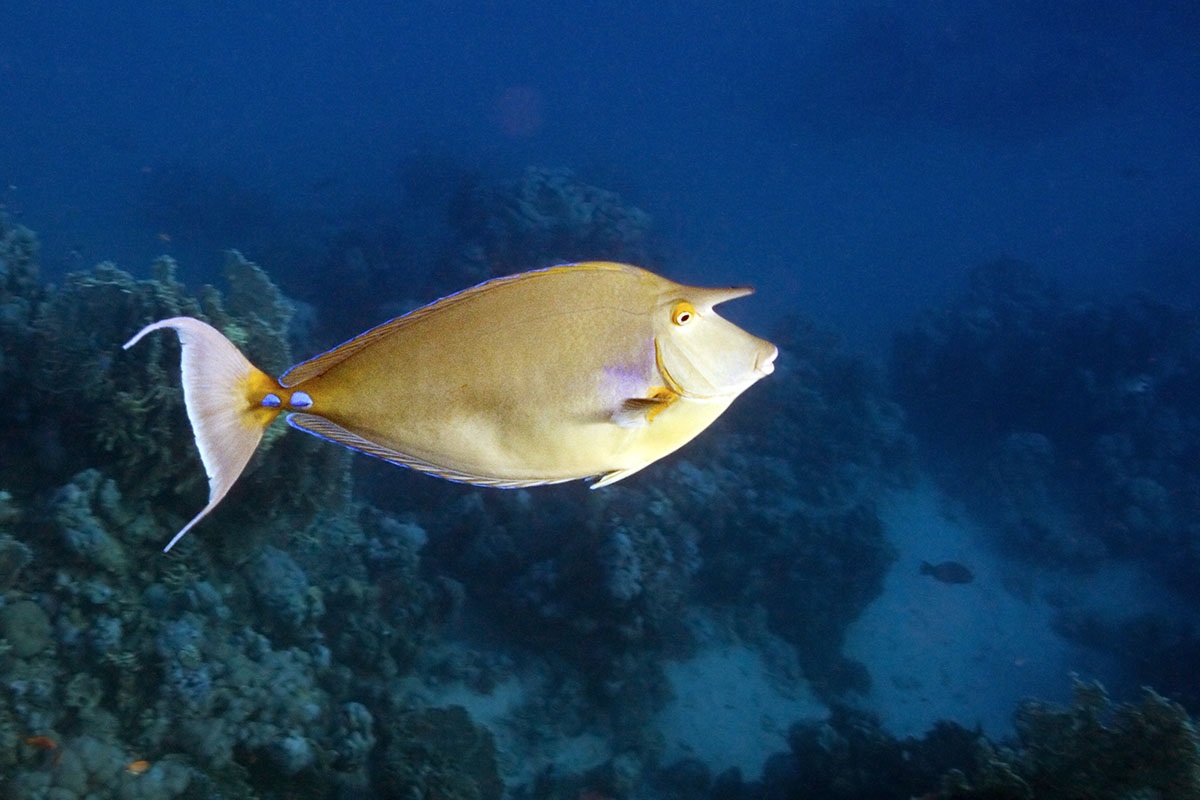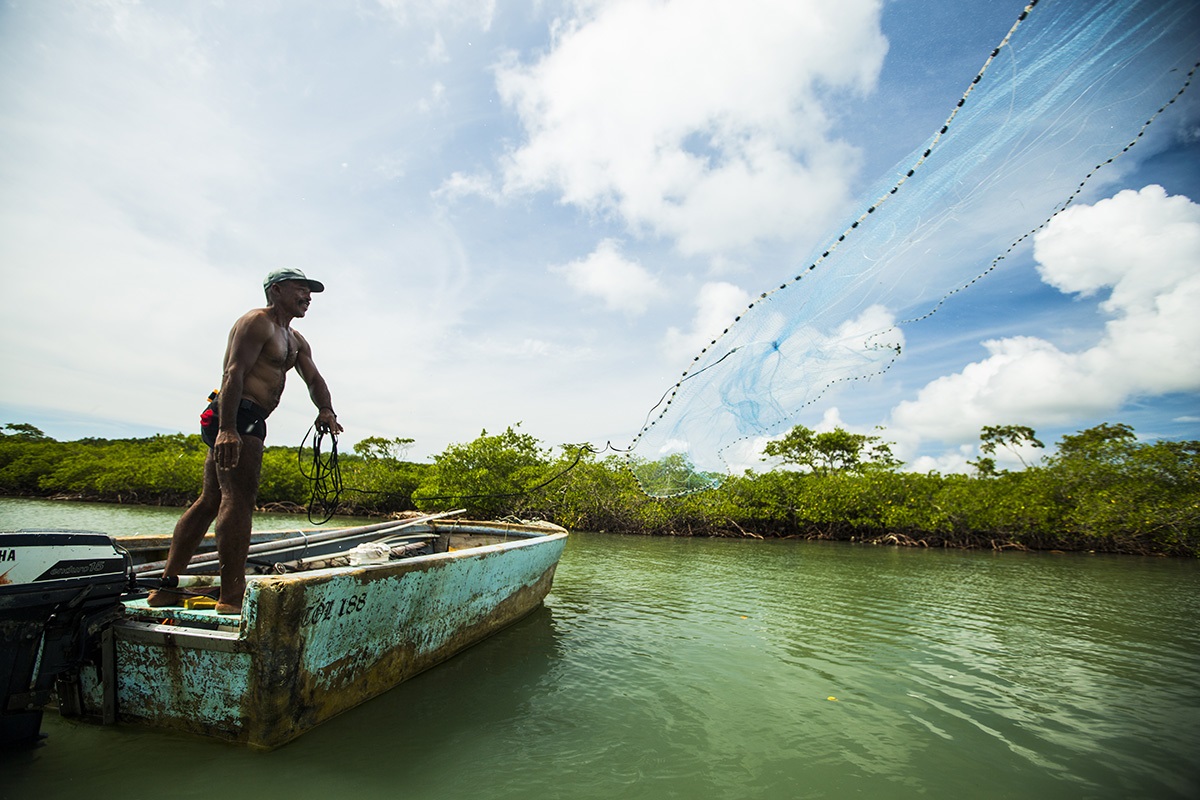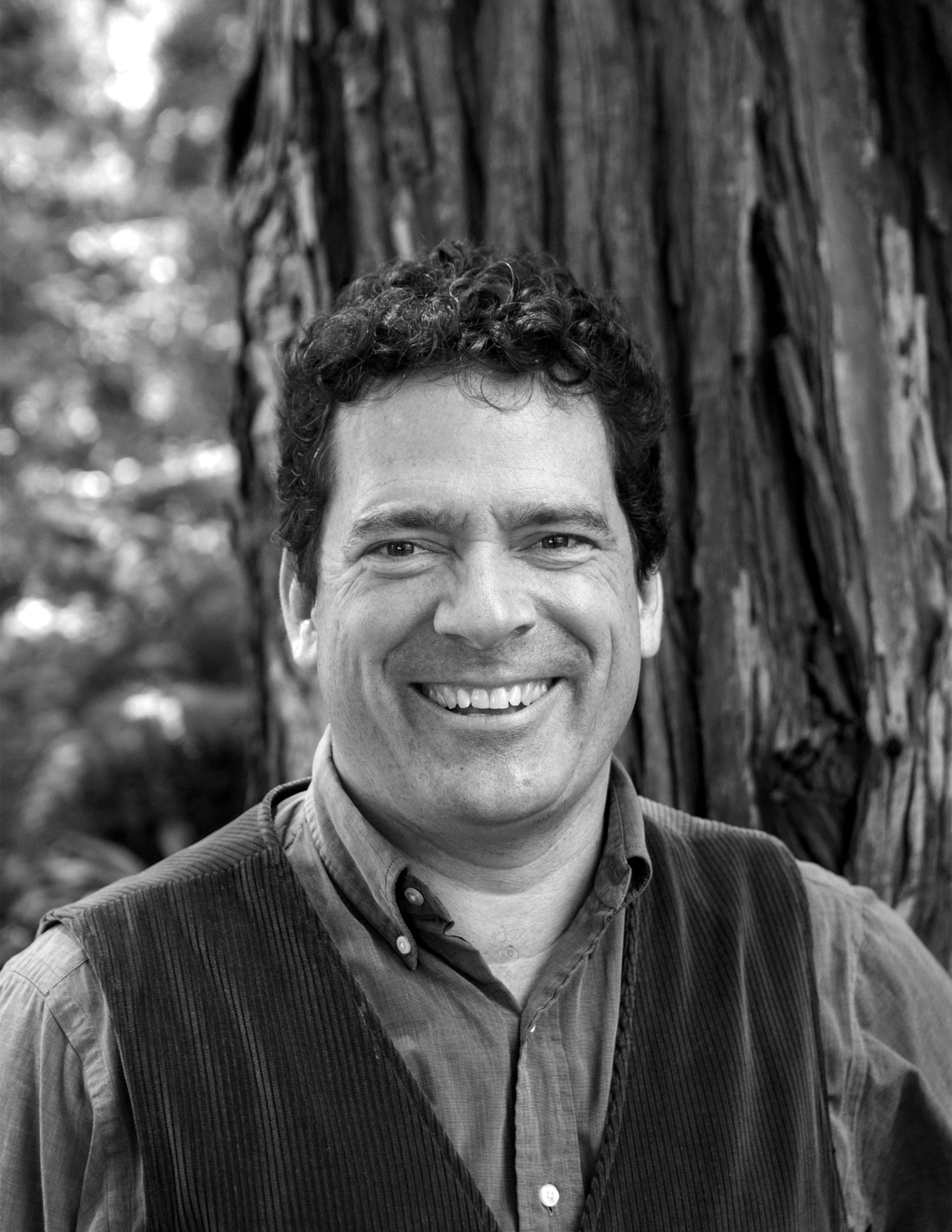The addiction began when I was 12, overpowered by the pull of psychedelic colors. The fix was immersion with snorkel and mask in the warm waters of that fringing coral reef in Kaua’i. There, countless Moorish idols, masked triggerfish, wrasse, and polka-dotted boxfish swam about their business. A lionfish glowered; a spotted ray glided past. Amidst Darth Vader breaths I heard the background crackle of feeding shrimp, punctuated by the crunch of parrotfish teeth on coral. Above all, near shore swam the strange big fish I came to know in an almost proprietary way: a resident school of kala. The tang species can grow two feet long, with olive-yellow skin, astonished eyes, cobalt tail spots, and a thin horn protruding from the head which gives its name: Naso unicornis, or bluespine unicornfish.
The rush couldn’t last. Back on the beach, I shook saltwater from my ears as six heavy-set locals, or kane, came trudging across the sand past me. The men surveyed the sea like surfers watching wave breaks. But the water was calm. They hadn’t come to play.
They wore cutoff jeans, neoprene booties, sideburns, and moustaches. A few carried dive masks with broken straps and a fine-mesh gillnet. The group eased in chest deep and took positions. Deep breaths, a nod from the leader, and the work began.
They formed an arc. Those in masks ducked underwater. Others maneuvered backward or sideways, fast as crabs, quietly gesturing with hands, heads, or feet. The group rotated, pulled the net taut, and burst into violent splashing. Their half-circle spiraled inward, then out, as men yanked the net down, pinned it to the sand with a foot, then leaned back as a tight-knit system. Soon their net quivered with life until they dragged it up onto the shore in a tangled heap.
As the men picked out their catch I counted a dozen of the gasping animals. Their glimmering scales faded to a dull sheen, blotted with wet sand. My unicornfish. Unable to get close while snorkeling, I reached out now to touch the rough skin as the gills stopped moving.
This impromptu Hawai’ian fish harvest, or hukilau, lasted all of 15 minutes. Then the fishermen vanished into the trees. While shaking out beach mats, my parents marveled at “an art” more authentic than the “canned shtick at Fern Grotto.” It felt like I’d been mugged, and I resented the menacing strangers at our pristine reef who killed my fish.
* * *
Ostensibly, the sea is free. It belongs to anyone and everyone, outsider or local, tourist or harvester. My liberty to snorkel meant their liberty to find the shortest distance from the reef to hand to mouth. But it was clear even then that open access to all could lead to collapse if there was nothing to sort out my visual hunger or their real hunger. That’s when my addiction got complicated.
I couldn’t see it at the time, but what I was witnessing that morning was part of an informal but effective and longstanding system, which revealed that the nearshore commons need not be tragic.
I was still sulking that evening at an informal cafe where my family ordered fresh poi, made of pounded local taro root, and “mahi-mahi,” or dolphinfish, whose thin but firm, moist filets vanished from our plates. On my way to the bathroom, I made a wrong turn. In the garbage outside the kitchen I saw the heads and bony remains of the dinner I’d just devoured. My stomach clenched as I noticed the protruding horn of a unicornfish.
At the kitchen door, I looked up at the cook and dishwasher. They were the same men from the beach, who had been holding the net. That’s when I made the link between supply and demand, producer and consumer, complicit in nudging Naso unicornis closer to local extinction. I met the guilty, menacing stranger who poaches fish and leaves a hole in the sea, and it was me.
Worse, I was far from alone. My middle-class family was then, in 1980, part of a rising human tide encroaching on the earth’s shores. Over the previous two decades, annual tourism to these remote islands had mushroomed from 100,000 overnight visitors to 3.5 million. Within a decade it would double. Haena reef was a sleepy patch on a secluded coast of the farthest northwestern island in the last colonized archipelago in the most distant patch of the largest ocean. Human impacts on the sea here meant that on more densely populated shores the pressure would be crushing. Soon there’d be nothing left to see, or to harvest. As the men looked at me, I felt I should say something to stop us all from crossing a point of no return. But as our eyes connected, we remained silent.
Garrett Hardin crystalized this fatalistic mindset in a parable that went beyond wild fish to put at stake the existence of all life. By 1968, Hardin had grown so troubled by overpopulation and the biological imperative to breed (a concern that emerged only after he became a father of four), that he constructed a metaphor about the dangers of free will. In an open-access public “commons,” every producer is aware that natural resources—from a grassy pasture to a shore filled with unicornfish—are finite, but each is compelled to harvest past the point of irreversible systemic collapse. “Ruin is the destination toward which all men rush, each pursuing his own best interest in a society that believes in the freedom of the commons,” Hardin wrote. “Freedom in a commons brings ruin to all.”
This “tragedy” fueled authoritarian impulses among liberals and conservatives alike. Left and Right agreed coercion was the only solution, and only differed over where and against whom to apply force. To prevent this chaos of human appetites, the sovereign state faced two mutually exclusive options in the nearshore ocean commons: Either police could guard public natural resources from private theft via strict regulation (i.e. marine reserves). Or police could guard private property from public theft through strict privatization (i.e. fish farms).
But what if there was more to it than this public-private dichotomy? What if there was a force to reverse the vicious cycle and turn the tide in favor of a resilient and productive reef?
It turns out there was, and, with trust, can be once more. The late Nobel laureate Elinor Ostrom showed how traditional communities around the world evolved informal systems for self-regulating their access to and use of natural resources. From ridge out to reef, Hawai’ians had clearly defined rules, or pono, that judiciously guided equitable harvests, trade, and natural resource stewardship, or malama. Their system, known as ahupua’a, was an ancient form of what we now call “territorial user rights to fishing,” or TURFs, that have evolved along tropical coastlines throughout the Pacific, from Fiji and Vanuatu to the Cook Islands and Palau to Northern Australia. In industrial nations, while big, regulated commercial fisheries like cod, whiting, snapper, or pollock get all the attention, it is these small-scale, nearshore fisheries that hold real potential for secure fishing rights as ocean governance shifts responsibility toward local hands.
* * *
Building on the work of Elinor Ostrom, researchers have now examined hundreds of fisheries globally and found that a key to recovery is to empower fishermen with secure, long-term rights to the resource; in exchange, they adhere to responsible limits on what they catch. This unlocks a profound stewardship incentive: Fishermen (along with restaurants and tourists) benefit financially as fish populations rebound.
Traditional and formal fishing rights have been taking shape around the world for years. After decades of decline in the United States, many of the biggest commercial fisheries have now adopted “catch shares.” Under these systems, fish populations are rebounding, while the number of fishing jobs has increased 23 percent, and fishing revenues are up 30 percent. They boost resilience. Even reef fisheries in the Gulf of Mexico, hard hit by the 2010 Deepwater Horizon oil spill, are doing better. Red snapper catches have more than doubled, revenues have increased by 108 percent, and today there are three times more red snapper in the ocean. Last year, with two-thirds of federally managed fisheries under catch shares, the U.S. government announced that overfishing was at an all-time low.
For another example, consider Belize, which in recent decades suffered sharp declines in reef fish and conch; spiny lobster harvests shrank from 200 per day to 20 for many fishermen. Then two groups of fishermen tried a new approach called “managed access”—essentially a TURF—granting them secure rights to their historical fishing areas, and everything changed. Early adopters saw a dramatic decline in illegal fishing, fish populations started to stabilize and rebound, and fishing businesses grew. Fishermen became champions of nearby marine protected areas. Word spread up the coast until nearly all 3,000 fishermen wanted the same opportunities. Recently, Belize voted to scale its TURFs nationwide.
In the Philippines, where 85 percent of fishermen are small scale and more than half of the animal protein in the country’s diet comes from fishing, the nearshore commons was in trouble until recently. Overfishing meant the catch of the average hook-and-line fisherman had dropped from 72 pounds per trip in the 1970s to just 7 pounds today. But there, too, coastal communities are forming TURFs, linking exclusive access rights and responsibilities.
In a race against time, can the rights-based renaissance of nearshore fisheries take root fast enough? In remote places, there are signs that the old unwritten rules may still be intact, offering a cornerstone on which to build trust.
I couldn’t see it at the time, but I was witnessing part of an informal but effective system, which revealed that the nearshore commons need not be tragic.
“Daddy,” she sputtered. “Did you see them? The funny-looking ones?”
She described several large round fish with blue spots near their tails. The big ones, she said, appeared to have horns growing out of their foreheads.
She wanted to know their name.






